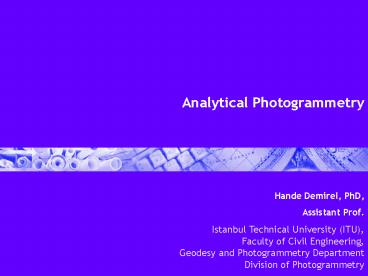Analytical Photogrammetry - PowerPoint PPT Presentation
1 / 23
Title:
Analytical Photogrammetry
Description:
Image and object coordinates. to employ adjustment theory to ... 'Geo-technology, as one of the three most important emerging and evolving fields, ... – PowerPoint PPT presentation
Number of Views:1168
Avg rating:5.0/5.0
Title: Analytical Photogrammetry
1
Analytical Photogrammetry
Hande Demirel, PhD, Assistant Prof. Istanbul
Technical University (ITU), Faculty of Civil
Engineering, Geodesy and Photogrammetry
Department Division of Photogrammetry
2
Aim
- Mathematical basics
- Image and object coordinates
- to employ adjustment theory to photogrammetric
measurements. - block adjustment based on bundles
3
Instructor
- Hande DEMIREL, PhD
- Istanbul Technical University
- Faculty of Civil Engineering
- Department of Geodesy and Photogrammetry
- Division of Photogrammetry,
- Ayazaga, 34469, Istanbul
- 212- 285 6110
- hande.demirel_at_itu.edu.tr
- http//www.ins.itu.edu.tr/jeodezi/fotog/hdemirel
/
4
Address
Consultancy Wednesday 1000 1300
5
Contents
- Introduction
- Coordinate Transformation
- Projective Equations
- Aerotriangulation
- Least Squares Adjustment
6
Intranet-aided course
- Everything (almost) will be available
- at the Web site
- It is imperative that you should
- have an e-mail address
- and be comfortable with a browser (Internet
Explorer or Netscape) - http//www.ins.itu.edu.tr/jeodezi/fotog/hdemirel
7
Literature
- Elements of Photogrammetry with Applications in
GIS, by Paul R. Wolf, Bon A. Dewitt, 2000,
McGraw- Hill Companies, Inc. USA - Fotogrametri by Karl Kraus, ( trans. O.Altan et
al.), 2003, Nobel Yayin evi, Turkey - Photogrammetrie by K. Regensburger, 1990, VEB
Verlag für Bauwesen, Germany
8
Resources
- Library of ITU
9
Resources
- Library of ITU
10
Resources
- ISPRS
- http//www.isprs.org/links/tutorial.html
11
Leading Journals
- ISPRS JOURNAL OF PHOTOGRAMMETRY AND REMOTE
SENSING - Quarterly
- ISSN 0924-2716
- ELSEVIER SCIENCE BV, PO BOX 211, AMSTERDAM,
NETHERLANDS, 1000 AE - PHOTOGRAMMETRIC ENGINEERING AND REMOTE SENSING
- Monthly
- ISSN 0099-1112
- AMER SOC PHOTOGRAMMETRY, 5410 GROSVENOR LANE
SUITE 210, BETHESDA, USA, MD, 20814-2160 - PHOTOGRAMMETRIC RECORD
- Quarterly
- ISSN 0031-868X
- BLACKWELL PUBLISHING, 9600 GARSINGTON RD, OXFORD,
ENGLAND, OXON, OX4 2ZG - Photogrammetrie, Fernerkundung, Geoinformation,
E. Schweizerbartsche Verlag, published monthly
by the German Society.
12
Leading Journals
13
Introduction
14
Spatial Information Science
- Geo-technology, as one of the three most
important emerging and evolving fields, along
with nanotechnology and biotechnology , U.S.
Department of Labor, (2004, Gewin, Nature)
15
Spatial Information Science Why?
- role played by geospatial analysts, mining
satellite images for information to help
authorities make crucial decisions. - geospatial technologies have changed the face and
broadened job prospects across public and private
sectors. - private sector hasn't traditionally offered many
jobs, but location-based services and mapping -
or 'geographic management systems'- are changing
the field. - US 5-billion worldwide geospatial market will
grow to 30 billion by 2005 - NASA26 of its most highly trained geotech staff
are due to retire in the next decade, and the
National Imagery and Mapping Agency is expected
to need 7,000 people trained in GIS in the next
three years.
16
Spatial Information Science Why?
- The demand for geospatial skills is growing
worldwide, but the job prospects reflect a
country's geography, mapping history and even
political agenda. - In the United States, the focus on homeland
security has been one of many factors driving the
job market. Another is its vast, unmapped
landscape. - European countries are integrating GIS into
government decision-making, their well-charted
lands give them little need for expensive
satellite imagery.
17
Spatial Information Science Why?
- The integration capabilities have extended
research frontiers across many fields, in the
areas ranging from ecology to medicine to
transportation. - Geographic information science and technologies
have today become critical components of the
global science infrastructure both in the
university and in society.
18
Spatial Information Science Geomatics
http//www.lrz-muenchen.de/t5831aa/WWW/Links.html
19
Definition
- Photogrammetry has been defined as the art,
science and technology of obtainning reliable
information about physical objects and the
environment through processes of recording,
measuring and interpreting photographic images
and patterns or recorded radiant electromagnetic
energy and other phenomena. (American Society for
Photogrammetry and Remote Sensing (ASPRS))
20
Definition
- Photogrammetry is the technique of measuring
objects (2D or 3D) from photo-grammes. We say
commonly photographs, but it may be also imagery
stored electronically on tape or disk taken by
video or CCD cameras or radiation sensors such as
scanners. The results can be - coordinates of the required object-points
- topographical and thematical maps
- and rectified photographs (orthophoto).
21
Definition
- The name photogrammetry" is derived from the
three Greek words phos or phot which means light,
gramma which means letter or something drawn, and
metrein, the noun of measure.
22
Analytical Photogrammetry
- Analytical Photogrammetry is a term to describe
the rigorous mathematical calculation of
coordinates of points in object space based upon
camera parameters, measured photo coordinates and
ground control. - Analytical photogrammetry generally involves the
solution of large, complex systems of redundant
equations by the method of least squares.
23
Image and Object Space































